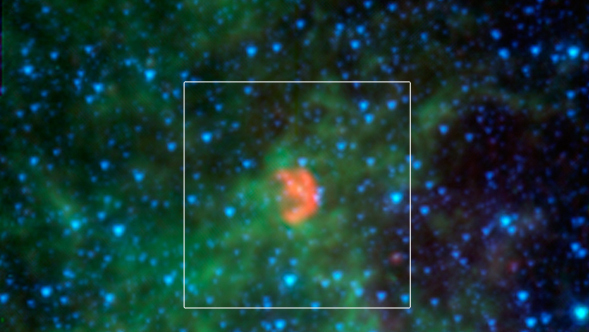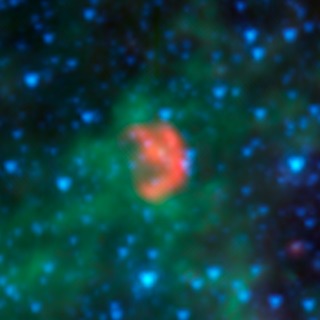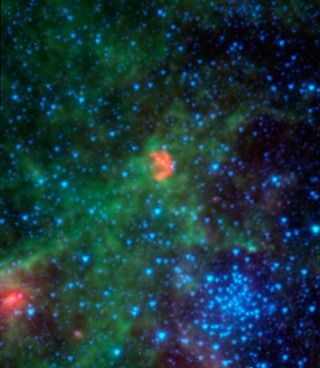
Credit: NASA/JPL-Caltech/Goddard
Observation • June 4th, 2014 • sig14-013
sig14-013
This infrared image from NASA's Spitzer Space Telescope shows N103B -- all that remains from a supernova that exploded a millennium ago in the Large Magellanic Cloud, a satellite galaxy 160,000 light-years away from our own Milky Way.
Spitzer's instruments pick up infrared light emitted by dust in both the remnant and the surrounding interstellar medium. The infrared light has been translated to colors we see in this image, allowing astronomers to dissect the scene. In this image, dust associated with the remnant appears red, while dust in the ambient background of the galaxy appears yellow and green. Stars in the field appear blue.
By studying the infrared light emitted from this supernova remnant, astronomers have determined that the density of the gas surrounding the supernova is much higher than is typical for a 'Type Ia' supernova, which are those that occur when dead stars called white dwarfs explode. Astronomers believe that this dense material was expelled prior to the supernova explosion, possibly by a companion to the white dwarf -- an aging star that shed the material.
Most Type Ia supernovas do not show evidence for this process occurring, making N103B an example of a rare subclass of Type Ia explosions. In fact, only one other remnant of a Type Ia explosion shows evidence for this: the remnant of Kepler's supernova in our own galaxy, the remains of the explosion of a star witnessed on Earth in 1604 A.D.
The clump of blue stars seen at the lower right is the cluster known as NGC 1850. Also a resident of the Large Magellanic Cloud, this cluster is made up of young stars yet has the appearance of globular clusters in the Milky Way, which are much older.
The red data shows infrared light with wavelengths of 16 and 24 microns, while shorter-wavelength infrared light of 3.6, 4.5, and 8 microns is shown as blue, cyan and green, respectively.
About the Object
- Name
- N103B • NGC 1850
- Type
- Nebula > Type > Supernova Remnant
- Star > Grouping > Cluster
- Distance
- 160,000 Light Years
Color Mapping
| Band | Wavelength | Telescope |
| Infrared | 3.6 µm | Spitzer IRAC |
| Infrared | 4.5 µm | Spitzer IRAC |
| Infrared | 8.0 µm | Spitzer IRAC |
| Infrared | 16.0 µm | Spitzer IRS |
| Infrared | 24.0 µm | Spitzer MIPS |
Astrometrics
- Position ()
- RA =5h 8m 58.9s
- Dec = -68° 43' 51.5"
- Field of View
- 4.9 x 5.7 arcminutes
- Orientation
- North is 1.6° right of vertical






